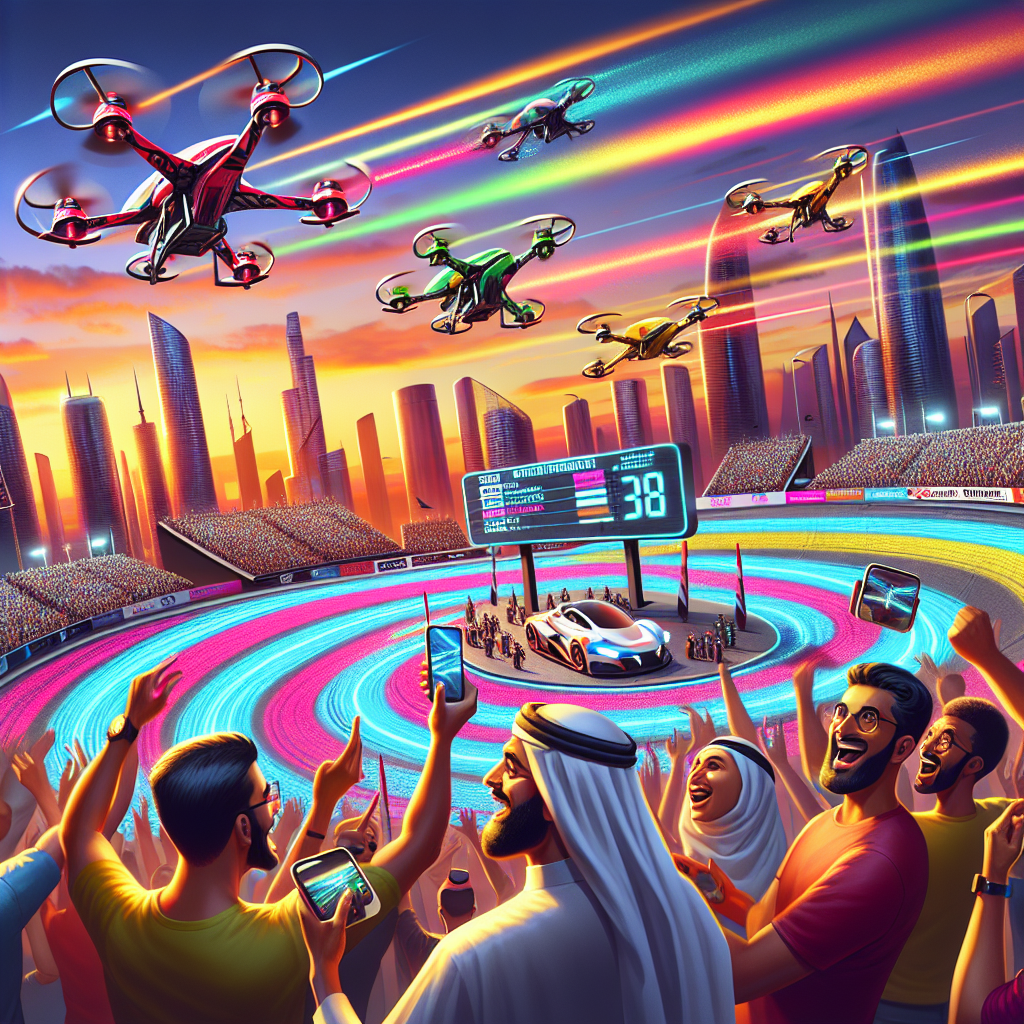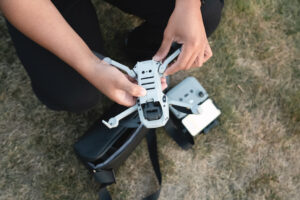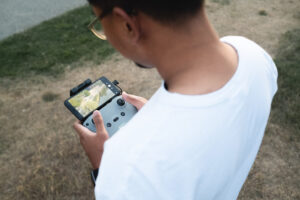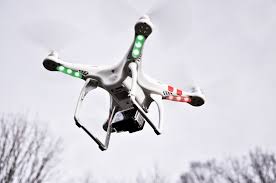
Hey there, drone racing enthusiasts! It’s time to buckle up and get serious about safety because in the high-octane world of FPV racing, the right gear can make all the difference between a triumphant finish and a crash landing. Let’s dive into the essentials of safety gear that will keep you flying high and coming back for more thrilling races.
Soaring Safely: FPV Racing Drone Safety Essentials
When you’re piloting a drone at breakneck speeds, the adrenaline rush is unbeatable. But with great speed comes great responsibility. Safety isn’t just a buzzword; it’s the backbone of sustainable and enjoyable FPV racing. Whether you’re a rookie getting your propellers wet or a seasoned pilot with lightning-fast reflexes, the right safety gear is non-negotiable.
Article-at-a-Glance: FPV Racing Drone Safety
- Helmet Power: Protect your head, the command center for your drone racing skills.
- Goggle Game: Your window to the drone’s perspective needs to be clear and comfortable.
- Insurance Assurance: Cover your gear and your back in case of mishaps.
- Pre-flight Protocol: A must-do checklist to keep your drone in top racing condition.
- Legal Eagle: Know the rules of the skies to keep your racing fun and fine-free.
Now, let’s gear up and get into the nitty-gritty of each safety essential.
Primary Safety Gear Checklist for FPV Pilots
Before you zip through the air, let’s make sure you’re equipped with the basics:
- FPV Goggles: They’re not just for show; they’re your eyes in the sky. Make sure they fit well and don’t fog up.
- Helmet: A no-brainer, literally. Protect your head with a sturdy helmet.
- Insurance: It’s like a parachute for your wallet. Accidents happen, and it’s smart to be prepared.
- Spotter: A buddy who keeps an eye on your drone and the surroundings. Two sets of eyes are better than one.
- First Aid Kit: Scrapes and bruises can occur. Be ready to patch up and get back to racing.
Each piece of gear is a layer of protection that lets you focus on the thrill of the race, not the risks.
Investing in Insurance: A Must for FPV Racing Enthusiasts
Think of insurance as your financial safety net. It might seem like an extra expense, but when your drone takes an unexpected tumble, you’ll be thanking your lucky stars (and your insurance provider) for helping you recover without breaking the bank.
Here’s the deal:
- Liability Insurance: Covers damage your drone might cause to others.
- Hull Insurance: Protects your own drone against damage or loss.
- Medical Insurance: For those rare occasions when you or someone else gets hurt.
Don’t fly naked, cover up with insurance!
![]()
“Fly Drone Images | Free Photos, PNG …” from www.rawpixel.com and used with no modifications.
Helmet Highs: The Pilot’s First Line of Defense
Imagine this: you’re in the zone, your drone is slicing through the air, and then – wham! An unexpected gust of wind sends it careening. Your spotter shouts, but it’s too late. The drone crashes, and parts fly everywhere. Good thing your head’s in a helmet, right?
Key Features of a Reliable FPV Racing Drone Helmet
Not all helmets are created equal. Here’s what to look for:
- Comfort: It should sit snugly on your head without squeezing your brains out.
- Durability: A tough outer shell to take the brunt of any impact.
- Ventilation: Keep a cool head with proper airflow, even when the race heats up.
Remember, a helmet isn’t just a safety requirement; it’s a statement that you’re a pilot who plays it smart.
Best Helmet Picks for Beginners and Pros
For the newbies: Start with something affordable but reliable. You don’t need all the bells and whistles just yet. For the pros: Invest in a helmet with built-in communication systems to stay in touch with your spotter or team.
“Safety isn’t expensive, it’s priceless.” – Unknown
Choose a helmet that feels like a part of you; it should be the last thing on your mind when you’re racing.
Visual Aids: Choosing FPV Goggles for Optimal Safety
FPV goggles are more than just a screen strapped to your face. They’re your most critical link to your drone. Without a clear and reliable view, you’re flying blind, and that’s a recipe for disaster.
Here’s what you need to focus on:
- Resolution: The sharper the image, the better your reaction time.
- Field of View (FOV): A wider FOV gives you a more immersive experience and better situational awareness.
- Comfort: You’ll be wearing these a lot, so make sure they don’t pinch or press.
Pick goggles that give you the clearest picture of your flight path and the obstacles around it.
Factors to Consider When Selecting FPV Goggles
Choosing the right goggles can be overwhelming, but focus on these key aspects:
- Resolution and clarity are paramount. The more pixels, the better.
- Adjustability: Look for goggles with adjustable IPD (Interpupillary Distance) for a comfortable fit.
- Battery Life: Longer battery life means less downtime and more flying.
Don’t skimp on your goggles; they’re as important as the drone itself.

“dji, drone, eyewear, fashion …” from www.pexels.com and used with no modifications.
The Intersection of Comfort and Field of View in Goggle Selection
Comfort and field of view (FOV) are two peas in a pod when it comes to choosing FPV goggles. You’ll want a wide FOV for an immersive experience, but not so wide that it distorts the image or makes you dizzy. And when it comes to comfort, think about the weight distribution and padding – after all, these goggles will be on your head for the long haul during races and practice sessions.
- Look for goggles with adjustable straps for a secure fit.
- Consider the weight of the goggles – lighter is usually more comfortable.
- Check for padding material that won’t irritate your skin over time.
- Some goggles have features like fan systems to prevent fogging – a clear view means a safe flight.
Remember, the right balance between comfort and FOV can keep you flying safely for hours.
Integrated Technologies: DVR and Head Tracking in Goggles
Modern FPV goggles come packed with features that can enhance your racing experience and safety. DVR (Digital Video Recorder) allows you to record your flights, which is invaluable for reviewing your performance and learning from your mistakes. Head tracking technology, on the other hand, lets you control the camera angle with your head movements, giving you a more intuitive flight experience.
- DVR can also be a lifesaver in case of a crash – you can review the footage to find your lost drone.
- Head tracking can help you anticipate turns and obstacles, making your flying smoother and safer.
- Look for goggles that allow for easy access to these technologies without being too complicated to use.
Integrate these tech features into your gear to not just race, but also to grow as a pilot.
Gearing Up: Protective Equipment Beyond the Goggles
While goggles are crucial, they’re just one piece of the safety puzzle. To protect yourself from the nicks and scrapes that come with the territory of drone racing, let’s talk gloves, pads, and the works.
The Role of Gloves in FPV Drone Racing
Gloves might seem like overkill until you’ve had to retrieve your drone from a thorny bush or a rough crash site. They protect your hands not just from cuts and scrapes, but also from the vibrations and grip strain of your controller during those intense races.
- Choose gloves that offer a good grip but don’t restrict your finger movements.
- Breathable materials will keep your hands cool under pressure.
- Touchscreen-compatible fingertips are a plus for quick adjustments on your devices.
Don’t let a small injury sideline you from your passion – glove up!
Importance of Knee and Elbow Pads During Flights
You’re not just sitting around when you’re racing drones. You’re moving, ducking, and diving, trying to keep up with your machine. Knee and elbow pads are your silent guardians, cushioning you against those sudden dashes to catch a falling drone or navigate through your racing environment.

- Look for pads that stay in place. You don’t want them sliding off at the crucial moment.
- Comfort is key – if they’re not comfortable, you won’t wear them.
- Durable materials are a must – these pads should take the hit so your joints don’t have to.
It’s not just about flying; it’s about being able to fly again tomorrow. Protect your joints!
Specialized Clothing: From Neck Gaiters to Flight Suits
When you’re out on the field, the right clothing can make a world of difference. It’s not just about looking the part; it’s about practicality and safety. Specialized clothing like neck gaiters can protect you from the sun’s harsh rays or a chilly breeze, while flight suits offer a layer of protection against scrapes and the elements.
- Neck Gaiters: Keep your neck covered from sunburn or windburn during long outdoor races.
- Flight Suits: Durable and with plenty of pockets, they’re perfect for keeping tools and spare parts handy.
- UV Protection: Long sleeves and pants with UV protection are smart choices for sunny days.
- Waterproof Gear: Don’t let a little rain stop your race. Waterproof jackets and pants can keep you dry and focused.
Dress for success, and in this case, success means staying safe and comfortable no matter the racing conditions.
Pre-flight Preparations: Safety Checks and Maintenance Rituals
Before you hit the throttle, a solid pre-flight routine is your first line of defense against mishaps. This ritual is all about making sure your drone is as ready to fly as you are. A thorough check can spot potential issues before they become real problems mid-air.

Step-by-Step Guide to a Thorough Pre-flight Safety Inspection
Here’s a quick checklist to run through before every flight:
- Inspect the frame for any cracks or damage.
- Ensure all screws and bolts are tight and secure.
- Check the motors and propellers for wear and tear.
- Verify that the battery is fully charged and properly mounted.
- Test all controls for responsiveness.
- Ensure your FPV system is transmitting clearly.
- Have a spotter ready to assist and watch for hazards.
A pre-flight check is like a pilot’s promise – a commitment to safety and responsibility every time you fly.
Routine Drone Maintenance Tips to Prevent Accidents
Regular maintenance is the unsung hero of drone safety. It’s not just about fixing things when they break; it’s about keeping them from breaking in the first place. Here are some tips to keep your drone in racing form:
- Clean your drone after every race, especially the motors and propellers.
- Check for loose connections or frayed wires.
- Update your drone’s firmware regularly for optimal performance.
- Store your batteries properly, in a cool and dry place.
- Keep a log of your flights and any issues you encounter.
Maintenance might not be glamorous, but it’s the backbone of a long and successful racing career.
Mastering Manual Mode: Flight Training and Skill Development
Flying in manual mode gives you complete control over your drone, and with that control comes the need for skill and finesse. It’s like the difference between driving an automatic car and a stick shift – manual mode is where the real pilots shine.

Simulator Training: Building Proficiency Before Real-World Flight
Before you take to the skies, simulators are your best friend. They’re risk-free environments where you can crash and burn as much as you need to, without the heartache of damaging your precious drone. Simulators help you:
- Get a feel for the controls without the pressure of a real flight.
- Practice complex maneuvers and build muscle memory.
- Learn how to react to unexpected situations.
- Experiment with different drones and settings.
Use simulators to hone your skills and build confidence, so when you do fly for real, you’re ready for anything.
Enhancing Spatial Awareness: The Transition to Flying with Goggles
Flying FPV can be disorienting at first. It’s a whole new perspective, and your brain needs time to adjust. Spatial awareness is key – understanding where your drone is in space, even when you can’t see it with your own eyes. Here’s how to make the transition smoother:
- Start with short flights to get used to the goggles.
- Practice in an open area free of obstacles.
- Use simulators with FPV views to mimic the real experience.
- Work with a spotter to guide you and offer another perspective.
Remember, the goal is to make the goggles an extension of your own vision. With practice, you’ll be flying through gates and around obstacles like a pro.
“The best pilot is the one who walks away from every landing.” – Real talk from the drone racing community.
Stay safe, stay sharp, and I’ll see you at the finish line!

Accidents and Emergencies: Response Strategies for FPV Pilots
No matter how careful you are, accidents can happen. Being prepared with a solid emergency action plan is the key to handling these situations like a pro. A good plan will help you keep a cool head and ensure the safety of everyone involved, including your drone.
Creating and Following an Emergency Action Plan
Your emergency action plan should be as familiar to you as your controller. It doesn’t have to be complicated, just effective. Here’s what to include:
- A clear procedure for what to do if your drone becomes uncontrollable or goes out of sight.
- Steps to take if your drone injures someone or damages property.
- Emergency contact numbers, including local authorities and your insurance provider.
- A recovery plan for retrieving your drone safely.
- A method for documenting the incident for insurance or regulatory purposes.
Practice this plan until it’s second nature. In the heat of the moment, you’ll be grateful for the muscle memory.
Essential Items for Your FPV Drone Racing First Aid Kit
Your first aid kit should be as much a part of your gear as your goggles. Here’s what to pack:
- Band-aids and antiseptic wipes for minor cuts and scrapes.
- Gauze, tape, and scissors for larger injuries.
- Pain relievers for those post-crash aches.
- Emergency blanket – it’s compact and can be a lifesaver in shock situations.
- Latex gloves because safety is also about hygiene.
Keep this kit updated and replenished, so you’re always ready to handle any bumps or bruises.

Understanding Local Laws and Regulations
Flying your FPV drone isn’t just about the technical know-how; it’s also about knowing the rules of the sky. Local laws and regulations are in place to ensure everyone’s safety, and staying informed is part of being a responsible pilot.

“fpv-quadcopter-shot-… | Flickr” from www.flickr.com and used with no modifications.
Navigating the Legal Landscape of FPV Drone Racing
Legal requirements can vary wildly from place to place, so it’s crucial to do your homework. Here’s a starter list to keep you on the right side of the law:
- Know the maximum altitude and distance from the pilot that your drone is allowed to fly.
- Understand the no-fly zones in your area, such as near airports or government buildings.
- Be aware of any requirements for registering your drone with local authorities.
- Stay updated on changes to laws and regulations that may affect FPV drone racing.
Ignorance isn’t bliss when it comes to the law. Stay informed and stay legal.
Insights on Insurance: Protecting Your Passion Legally and Financially
Insurance might seem like a grudge purchase, but it’s actually an investment in your peace of mind. Here’s why:
- Liability insurance can save you from financial ruin if your drone causes damage or injury.
- Some policies cover the cost of lost or damaged drones, which is a huge relief if you’re flying expensive gear.
- Insurance can also protect you against legal claims, covering legal fees and settlements.
Think of insurance as your invisible copilot, there to help navigate the unexpected.
FAQ: Fast-tracking FPV Fundamentals
Got questions? You’re not alone. Here are some quick answers to common queries that can help you stay safe and informed in the world of FPV drone racing.

What are the top 3 most critical pieces of safety gear for FPV racing?
Without a doubt, the top three are:
- FPV Goggles: For clear vision and control.
- Helmet: To protect your noggin.
- Insurance: Because accidents don’t ask for permission.
These are your safety trifecta, the non-negotiables for any serious FPV pilot.
Can you fly an FPV racing drone without goggles?
Technically, yes, but it’s like driving a car with a blindfold. FPV goggles give you the first-person view needed to pilot your drone accurately and safely. Flying without them is not recommended and can be dangerous.
What are the legal requirements for flying FPV drones in populated areas?
The specifics can vary, but generally, you’ll need to:
- Keep a certain distance from people and private property.
- Avoid flying over crowds or events without permission.
- Be aware of and comply with any local curfews or restrictions.
Always check the regulations in your area before you fly to avoid any legal turbulence.
How often should you perform maintenance checks on your FPV racing drone?
Maintenance checks should be done:
- Before every flight session (pre-flight checks).
- After any crashes or hard landings.
- At regular intervals, depending on how often you fly.
Regular checks keep your drone racing at peak performance and can prevent accidents caused by equipment failure.
Remember, knowledge is power, especially when it comes to FPV drone racing. Stay safe, stay informed, and most importantly, have fun mastering the skies!
What are the top 3 most critical pieces of safety gear for FPV racing?
Let’s cut to the chase. The three must-haves in your safety arsenal are:
- FPV Goggles: They’re your eyes in the sky. Without them, you’re flying blind.
- Helmet: It’s your personal crash helmet. A good one keeps your smarts intact for smart flying.
- Insurance: It’s the parachute for your wallet. When things go south, it’s got your back.
These three form the safety trifecta that every FPV pilot should be geared up with before taking off.

Can you fly an FPV racing drone without goggles?
Here’s the deal: you could, but why would you want to? FPV goggles are what make racing truly immersive and precise. Flying without them is like threading a needle with your eyes closed – possible, but unnecessarily risky and tricky. So, for the sake of safety and the full FPV experience, keep those goggles on.
What are the legal requirements for flying FPV drones in populated areas?
When it comes to flying in populated areas, the rules get tighter:
- Keep a safe distance from people and private property – no peeping Tom maneuvers.
- Steer clear of flying over groups of people or events unless you’ve got the green light.
- Check for any local flight curfews or restrictions that might ground your plans.
Always do your homework before you fly. Knowing the local laws keeps you out of trouble and in the air.
- Before every flight, give your drone a once-over with a pre-flight check.
- After any rough landings or crashes, inspect your drone for damage.
- Set a maintenance schedule based on how often you fly. The more you fly, the more love your drone needs.
Stick to a solid maintenance routine, and your drone will stick with you through countless races.
| Safety Gear | Description |
|---|---|
| FPV Goggles | VR headset or AR glasses for immersive flying experience
|
| Helipad | A landing pad for safe and stable drone landings
|
| Lanyard | A safety cord to prevent drone loss during flight
|
| Camera | A high-quality camera for capturing footage during flight
|
| Sunscreen | Protects the drone from bright sunlight
|
| Indicator Lights | Enhances visibility during twilight or low-light conditions
|
| Case or Bag | Protects the drone during transportation and storage
|
| Cables | Essential for connecting and charging the drone
|
| Folding Camping Table | A portable table for holding accessories during flight
|
| Zip Ties | Useful for securing cables and other components
|
| Silicone Electrical Wires | Various gauges for power, motor, and signal connections
|
| Hex Screwdriver Set | For tightening and loosening hex screws on the drone
|
| 3D Printed Parts | Customizable and durable components for drone builds
|
| Heat Shrink | Protects wires and connections from damage
|
| Various Tapes | For securing and protecting components during flight
|
Remember that safety should always be your top priority when flying an FPV drone. Make sure to have all the necessary safety gear and equipment to ensure a safe and enjoyable flying experience.


